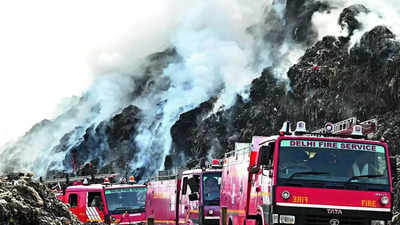- News
- City News
- delhi News
- With point of origin tough to find, it’s a fight like no other for firemen
Trending
With point of origin tough to find, it’s a fight like no other for firemen
Landfill fires pose unique challenges for firefighters, including unstable terrain, limited water supply, and dynamic fire origins. Atul Garg recommends using dust and concrete to restrict oxygen and aid extinguishing efforts.

With the possibility of fire tenders sinking into a heap of garbage, the firemen have to exercise extreme care
NEW DELHI: Fires at landfills pose unique challenges for the fire service. Unlike the regular infernos, landfill fires lack a centralised point of origin, making it harder for the firefighters to effectively target the source. The ground itself betrays the fire personnel, being a treacherous landscape of undulating mounds and unstable slopes. Water, their most trusted ally, is often in inadequate supply in the desolate wasteland.
Firefighters say that when responding to blazes in the usual locations such as homes and industrial complexes, they can generally pinpoint the origin point of the flames.This useful information is missing in the case of an inferno at a landfill. And being mostly gaseous in origin, the flames can erupt at any one or many spots. “The vast expanse of a landfill, combined with the diverse range of materials present, makes it difficult to pinpoint the exact location where the fire started,” an officer said.
Another problem for the fire brigade at landfills is the extreme care needed to drive the fire tenders. There is every possibility that the vehicles will sink into a heap of garbage. “The instability of the garbage mounds increases the likelihood of fire engines becoming trapped or even toppling over. Also there is no particular route by which we can climb to the top of the mounds,” the officer added.
The primary challenge, of course, lies in the absence of a water source in the proximity of landfills. The fire-fighting teams often have to drive to nearby stations to replenish their water supply before returning to the burning site, an imperative that results in wastage of time and general inefficiency.
He noted that the absence of readily accessible water sources near landfills significantly impedes the efforts to control and extinguish fires, leading to prolonged and more challenging firefighting operations. In contrast to the straightforward approach the firefighters can take in house, building or factory blazes, where the flames can be effectively extinguished by directing the water at the source of the fire, which remains localised for a period of time, in landfills, the origin is dynamic and water has, thus, to be directed at different spots at different times.
Atul Garg, director, Delhi Fire Service, said the district administration had been asked to provide dust, mud and concrete materials to extinguish the fire and to restrict the oxygen supply at the affected site. He explained, “A fire needs oxygen and if dust and concrete are spread at the burning spots at the landfill, these will cut off the oxygen supply.”
Firefighters say that when responding to blazes in the usual locations such as homes and industrial complexes, they can generally pinpoint the origin point of the flames.This useful information is missing in the case of an inferno at a landfill. And being mostly gaseous in origin, the flames can erupt at any one or many spots. “The vast expanse of a landfill, combined with the diverse range of materials present, makes it difficult to pinpoint the exact location where the fire started,” an officer said.
Another problem for the fire brigade at landfills is the extreme care needed to drive the fire tenders. There is every possibility that the vehicles will sink into a heap of garbage. “The instability of the garbage mounds increases the likelihood of fire engines becoming trapped or even toppling over. Also there is no particular route by which we can climb to the top of the mounds,” the officer added.
The primary challenge, of course, lies in the absence of a water source in the proximity of landfills. The fire-fighting teams often have to drive to nearby stations to replenish their water supply before returning to the burning site, an imperative that results in wastage of time and general inefficiency.
An officer, speaking about the operation at the Ghazipur landfill, where a fire has blazed since Sunday evening, said, “In the area of the landfill where the fire was ignited, we discovered there was no water source nearby. This hindered our operations.”
He noted that the absence of readily accessible water sources near landfills significantly impedes the efforts to control and extinguish fires, leading to prolonged and more challenging firefighting operations. In contrast to the straightforward approach the firefighters can take in house, building or factory blazes, where the flames can be effectively extinguished by directing the water at the source of the fire, which remains localised for a period of time, in landfills, the origin is dynamic and water has, thus, to be directed at different spots at different times.
Atul Garg, director, Delhi Fire Service, said the district administration had been asked to provide dust, mud and concrete materials to extinguish the fire and to restrict the oxygen supply at the affected site. He explained, “A fire needs oxygen and if dust and concrete are spread at the burning spots at the landfill, these will cut off the oxygen supply.”
End of Article
FOLLOW US ON SOCIAL MEDIA











